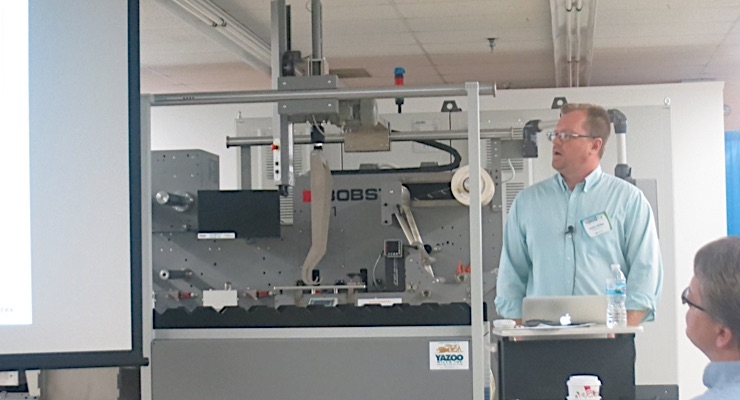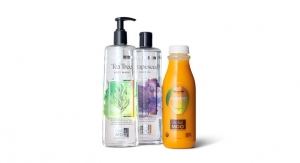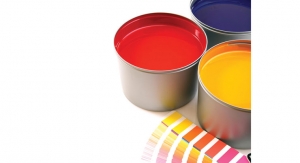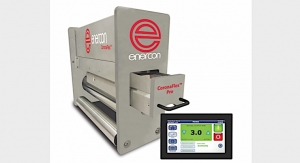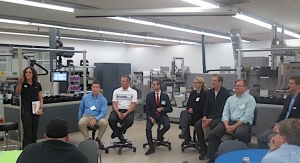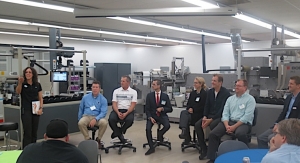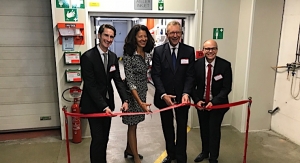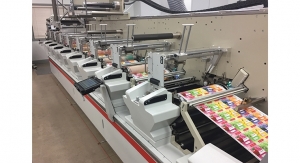Greg Hrinya, Associate Editor12.04.17
On November 9, All Printing Resources (APR) hosted the inaugural Narrow Web Flexible Packaging Summit at its Glendale Heights facility, just outside Chicago, IL, USA. In addition to live press demonstrations, panel discussions and networking opportunities, industry experts delved into some of the most important topics affecting converters today.
Among the issues discussed were ink adhesion and the benefits of corona treatment, and best practices for prepress and color consistency. Todd Krupa, national sales manager for narrow web at Enercon, explored how to properly prepare film stock for ink adhesion.
In discussing ink adhesion, Krupa explained that there are numerous benefits to corona treatment. Corona treatment performs several tasks, including air ionization, film surface oxidation, and it forms low molecular weight on a surface (LMWOM). There are several benefits to this process. Corona treatment increases surface wettability, increases run speeds, promotes ink adhesion, and provides insurance against waste and reruns.
“All films should be corona treated at the time of extrusion,” explained Krupa. “That’s going to commonly be referred to as pretreated films. This increases their receptiveness to treatment at the time of converting.”
Another form of quality assurance is “bump” treating. Bump treating eliminates the variable of surface energy from the printing process, and most printers will bump treat immediately prior to printing.
John Kilbo, OFC regional technical manager at Siegwerk and also a chemist, defined the mechanics behind ink adhesion. For UV ink adhesion, there are several categories: chemical bonding adhesion, mechanical interlocking adhesion, and diffusion adhesion. Chemical bonding adhesion is the strongest form, where two chemicals react to form a continuous molecule. Meanwhile, mechanical interlocking adhesion involves printing on top of a paper-absorbent substrate, allowing the ink to fill the voids or pores on the surface. This method increases surface area dramatically. Finally, diffusion adhesion creates an IPN (inter penetration network) through swelling and co-mingling with film resins.
“We try to look at all aspects of adhesion for difficult applications,” said Kilbo. “Printers are mainly looking at surface energy when we’re talking about ink adhesion, and we’re seeing them doubling their press speeds just by switching to LED.”
Catherine Haynes, SE technical solutions manager at APR, detailed color control and print consistency. When dealing with any of the three common press layouts–inline, stack, CI–many issues can affect ink letdown. They include: substrates and coatings, dyne levels, temperature, anti-foaming agents, chemical properties, color sequence, press speed, absorbency, impression, and ink film thickness.
According to Haynes, process control on press starts with optimization and press maintenance. It’s also important to identify the best combination of print variables to achieve design requirements.
“What are the ingredients that are going to result in success?” asked Haynes. “Bakers follow the same process, and that’s what we do. What are the inputs that are going to get us to where we want to go?”
All the variables for a print job must be optimized, whether talking about press components, such as dryers, registrations and tension controls, or job-specific variables like substrates, plates, aniloxes and inks.
A print job requires a deeper understanding of standards. What are the normal production conditions and graphic parameters? What are the target curves and gray balance, as well as density and dot gain? Measurement is key in answering many of these questions. For prepress, that means analyzing artwork–workflow solutions, preflighting, automation tasks–and color management– software, spectrophotometer and proofing. Plate evaluation, mounting, inks and metering are all part of this process too.
Mounting demands a TIR measurement, in which a user can verify that a circle is a circle, and so forth. Registration targets and consistent tape selection are also important steps. Meanwhile, inks must be tested for viscosity, temperature, and pH meter for water-based inks.
The converter’s goal is to provide repeatability. “It’s all about being able to achieve consistent color on press,” said Haynes. “This all hinges on being able to do it over and over again.”
In the pressroom, FTA FIRST recommends specific starting points for process colors. A new Techkon device will also enable the analysis of Spot Color Tone Value (SCTV) to use density for measurement of spot colors. In the past, that has generally been left to visual evaluation. This will come in handy for the measurement of spot colors for Pepsi blue and Coca-Cola red, for example.
Haynes added that it’s also important to have a proper press make-ready process. During the event, LPC, Inc.’s Jennifer Dochstader said that the No. 1 reason clients seek a new print vendor is due to job repeatability and color consistency.
Among the issues discussed were ink adhesion and the benefits of corona treatment, and best practices for prepress and color consistency. Todd Krupa, national sales manager for narrow web at Enercon, explored how to properly prepare film stock for ink adhesion.
In discussing ink adhesion, Krupa explained that there are numerous benefits to corona treatment. Corona treatment performs several tasks, including air ionization, film surface oxidation, and it forms low molecular weight on a surface (LMWOM). There are several benefits to this process. Corona treatment increases surface wettability, increases run speeds, promotes ink adhesion, and provides insurance against waste and reruns.
“All films should be corona treated at the time of extrusion,” explained Krupa. “That’s going to commonly be referred to as pretreated films. This increases their receptiveness to treatment at the time of converting.”
Another form of quality assurance is “bump” treating. Bump treating eliminates the variable of surface energy from the printing process, and most printers will bump treat immediately prior to printing.
John Kilbo, OFC regional technical manager at Siegwerk and also a chemist, defined the mechanics behind ink adhesion. For UV ink adhesion, there are several categories: chemical bonding adhesion, mechanical interlocking adhesion, and diffusion adhesion. Chemical bonding adhesion is the strongest form, where two chemicals react to form a continuous molecule. Meanwhile, mechanical interlocking adhesion involves printing on top of a paper-absorbent substrate, allowing the ink to fill the voids or pores on the surface. This method increases surface area dramatically. Finally, diffusion adhesion creates an IPN (inter penetration network) through swelling and co-mingling with film resins.
“We try to look at all aspects of adhesion for difficult applications,” said Kilbo. “Printers are mainly looking at surface energy when we’re talking about ink adhesion, and we’re seeing them doubling their press speeds just by switching to LED.”
Catherine Haynes, SE technical solutions manager at APR, detailed color control and print consistency. When dealing with any of the three common press layouts–inline, stack, CI–many issues can affect ink letdown. They include: substrates and coatings, dyne levels, temperature, anti-foaming agents, chemical properties, color sequence, press speed, absorbency, impression, and ink film thickness.
According to Haynes, process control on press starts with optimization and press maintenance. It’s also important to identify the best combination of print variables to achieve design requirements.
“What are the ingredients that are going to result in success?” asked Haynes. “Bakers follow the same process, and that’s what we do. What are the inputs that are going to get us to where we want to go?”
All the variables for a print job must be optimized, whether talking about press components, such as dryers, registrations and tension controls, or job-specific variables like substrates, plates, aniloxes and inks.
A print job requires a deeper understanding of standards. What are the normal production conditions and graphic parameters? What are the target curves and gray balance, as well as density and dot gain? Measurement is key in answering many of these questions. For prepress, that means analyzing artwork–workflow solutions, preflighting, automation tasks–and color management– software, spectrophotometer and proofing. Plate evaluation, mounting, inks and metering are all part of this process too.
Mounting demands a TIR measurement, in which a user can verify that a circle is a circle, and so forth. Registration targets and consistent tape selection are also important steps. Meanwhile, inks must be tested for viscosity, temperature, and pH meter for water-based inks.
The converter’s goal is to provide repeatability. “It’s all about being able to achieve consistent color on press,” said Haynes. “This all hinges on being able to do it over and over again.”
In the pressroom, FTA FIRST recommends specific starting points for process colors. A new Techkon device will also enable the analysis of Spot Color Tone Value (SCTV) to use density for measurement of spot colors. In the past, that has generally been left to visual evaluation. This will come in handy for the measurement of spot colors for Pepsi blue and Coca-Cola red, for example.
Haynes added that it’s also important to have a proper press make-ready process. During the event, LPC, Inc.’s Jennifer Dochstader said that the No. 1 reason clients seek a new print vendor is due to job repeatability and color consistency.

